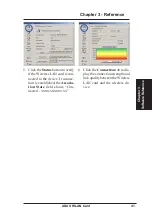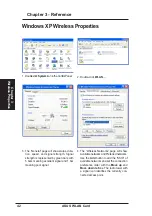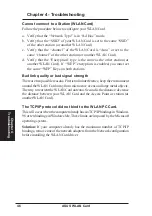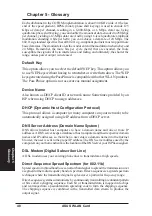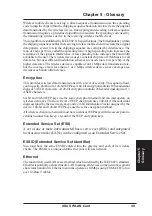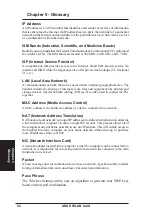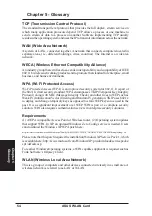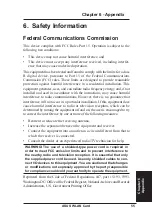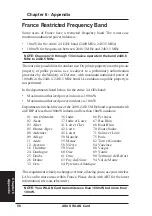
ASUS WLAN Card
51
Chapter 5
Chapter 5 - Glossary
Glossary
The 802.11a standard gains some of its performance from the higher frequencies at
which it operates. The laws of information theory tie frequency, radiated power and
distance together in an inverse relationship. Thus, moving up to the 5-GHz spectrum
from 2.4 GHz will lead to shorter distances, given the same radiated power and encoding
scheme.
Compared with 802.11g: 802.11a is a standard for access points and radio NICs that
is ahead of 802.11g in the market by about six months. 802.11a operates in the 5GHz
frequency band with twelve separate non-overlapping channels. As a result, you can
have up to twelve access points set to different channels in the same area without them
interfering with each other. This makes access point channel assignment much easier
and significantly increases the throughput the wireless LAN can deliver within a given
area. In addition, RF interference is much less likely because of the less-crowded 5
GHz band.
IEEE 802.11b (11Mbits/sec)
In 1997, the Institute of Electrical and Electronics Engineers (IEEE) adopted the 802.11
standard for wireless devices operating in the 2.4 GHz frequency band. This standard
includes provisions for three radio technologies: direct sequence spread spectrum,
frequency hopping spread spectrum, and infrared. Devices that comply with the 802.11
standard operate at a data rate of either 1 or 2 Mbps.
In 1999, the IEEE created the 802.11b standard. 802.11b is essentially identical to the
802.11 standard except 802.11b provides for data rates of up to 11 Mbps for direct
sequence spread spectrum devices. Under 802.11b, direct sequence devices can operate
at 11 Mbps, 5.5 Mbps, 2 Mbps, or 1 Mbps. This provides interoperability with existing
802.11 direct sequence devices that operate only at 2 Mbps.
Direct sequence spread spectrum devices spread a radio signal over a range of
frequencies. The IEEE 802.11b specification allocates the 2.4 GHz frequency band
into 14 overlapping operating Channels. Each Channel corresponds to a different set of
frequencies.
IEEE 802.11g
802.11g is a new extension to 802.11b (used in majority of wireless LANs today) that
broadens 802.11b's data rates to 54 Mbps within the 2.4 GHz band using OFDM
(orthogonal frequency division multiplexing) technology. 802.11g allows backward
compatibility with 802.11b devices but only at 11 Mbps or lower, depending on the
range and presence of obstructions.
Infrastructure
A wireless network centered about an access point. In this environment, the access
point not only provides communication with the wired network but also mediates
wireless network traffic in the immediate neighborhood.
IP (Internet Protocol)
The TCP/IP standard protocol that defines the IP datagram as the unit of information
passed across an Internet and provides the basis for connectionless packet delivery
service. IP includes the ICMP control and error message protocol as an integral part. It
provides the functional equivalent of ISO OSI Network Services.





